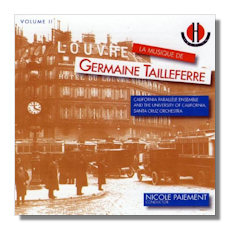
The Internet's Premier Classical Music Source
Related Links
- Taillefaire Reviews
- Latest Reviews
- More Reviews
-
By Composer
-
Collections
DVD & Blu-ray
Books
Concert Reviews
Articles/Interviews
Software
Audio
Search Amazon
Recommended Links
Site News
 CD Review
CD Review
Germaine Tailleferre

La musique de Germaine Tailleferre, Volume II
- 2 pièces for piano
- Concerto for Piano
- Pastorale in A-flat
- Partita
- Pastorale for violin and piano
- Concertino for Flute and Piano
- Impromptu
Josephine Gandolfi, piano
Leta Miller, flute
Susan C. Brown, violin
California Parallèle Ensemble
University of California, Santa Cruz Orchestra/Nicole Paiement
Helicon HL1048 57:77
Summary for the Busy Executive: Women's work?
Germaine Tailleferre, for most people who know her at all, is primarily a name in a list: one of Les Six, postwar French composers (more friends than an artistic group) who had a liking for Erik Satie's music in common – Francis Poulenc, Arthur Honegger, Darius Milhaud, Germaine Tailleferre, Georges Auric, and Louis Durey.
A prodigy, Tailleferre entered the Paris Conservatory at the age of 12, where she studied with Charles Koechlin and Maurice Ravel, among others, and won prizes in harmony and fugue. Her early music, influenced mainly by Fauré and Satie, won the admiration of Satie himself, who called her his "musical daughter." The years leading up to World War II saw the greatest recognition of her work, although such acclaim never reached the levels of Poulenc, Milhaud, or Honegger. You can make a case that this coolness stems from older attitudes toward women composers. After all, Aaron Copland wondered why there were no great ones, although he probably knew at least two. People tended to treat women composers as phenomena on the same level, to quote Dr. Johnson on women preachers, as "a dog walking on its hind legs. It is not done well; but you are surprised to find it done at all." Certainly Tailleferre suffered from this. Two bad marriages further hurt her career, although she bounced back a little from the Fifties until her death in 1983. In the meantime, some of her work became staples in the repertoires of instrumentalists, particularly harp and flute players. Her most ambitious work, La cantata de Narcisse (text by Paul Valéry), has never received a commercial recording, as far as I know.
Like the younger Jean Françaix (also influenced by Satie), Tailleferre's music generally keeps to modest limits, although she fills it with virtuosic and sophisticated matter. Her music can fool you into taking it too lightly, and many, good Romantics all, equating great with grandiose, have. According to Tailleferre herself, the sorrows of her life made her seek out uncomplicated joy in her art.
The CD's program divides into salon and concert pieces. The languid, triple-time Impromptu, the earliest work here (1912), reveals the inspiration of Fauré in its subtle, side-slipping harmony, with early Debussy, somewhere around the two Arabesques, showing up in the B section. The Pastorale in A-flat of 1928 boasts leaner textures, like the Poulenc Mouvements perpetuels, with lingering traces of Impressionism in some of the harmony. The 2 pièces come from 1928 and 1946. Tailleferre gathered them in 1962. The Larghetto is even more Poulenc-like than the Pastorale, while the Valse lente is chromatically lush, with surprising modulations to distant keys, emotionally nostalgic, and melodically memorable. Written in Occupied France, the violin-and-piano Pastorale (1942) rocks tenderly, like a boat on still water.
Tailleferre hit her stride in the Twenties, and the Piano Concerto (1925), premiered by the legendary Leopold Stokowski and his Philadelphia Orchestra, stands as one of the strongest works in her catalogue. The toccata first movement anticipates Bohuslav Martinů's piano writing a decade later, down to the Czech's trademark syncopations. The forlorn second movement begins with a bare two-voice texture. It wears its sorrows plainly, all the tougher for its directness without ever hectoring. The finale, a lively bransle, is joyous and breezy. The elation increases from Tailleferre's counterpoint, which like Bach's adds to its dancing quality as well.
After World War II and years of fitful inspiration, Tailleferre hit her stride again. The Concertino for flute and piano (1952; mislabeled on the CD as "Concerto") shows a new astringency, textural and emotional, similar to Milhaud. The sun comes out again in the Rondo finale. The latest work – the Partita for flute, oboe, clarinet, and strings (1962) – sings more ambiguously and Tailleferre condenses her thought more than ever before. In the first movement, we seem in some liminal space between classicism and surrealism. A ripple of psychological uneasiness runs through. The second movement opens with the three solo wind instruments, creating a barren sound landscape. When they enter, even the strings mourn. In the finale, in quick tempo but with the disquiet of the previous movements. It seems not to end, but to peter out.
The performers all do a fine job. Conductor Nicole Paiement conveys very well the psychological narratives of Tailleferre's music in all periods. My only complaint is a small one. The sound, although by no means awful, still seems a bit "home-made," as does the production booklet. Nevertheless, I'm very happy that someone decided to devote an entire disc to this underappreciated composer and hope that someone will continue to explore her catalogue.
Copyright © 2013, Steve Schwartz


















